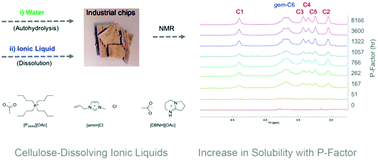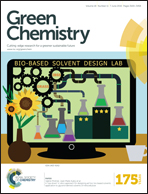Application of mild autohydrolysis to facilitate the dissolution of wood chips in direct-dissolution solvents†
Abstract
Wood is not fully soluble in current non-derivatising direct-dissolution solvents, contrary to the many reports in the literature quoting wood ‘dissolution’ in ionic liquids. Herein, we demonstrate that the application of autohydrolysis, as a green and economical wood pre-treatment method, allows for a massive increase in solubility compared to untreated wood. This is demonstrated by the application of two derivitising methods (phosphitylation and acetylation), followed by NMR analysis, in the cellulose-dissolving ionic liquids 1-allyl-3-methylimidazolium chloride ([amim]Cl) and 1,5-diazabicyclo[4.3.0]non-5-enium acetate ([DBNH][OAc]). In addition, the non-derivitising tetrabutylphosphonium acetate ([P4444][OAc]) : DMSO-d6 electrolyte also allowed for dissolution of the autohydrolysed wood samples. By combination of different particle sizes and P-factors (autohydrolysis intensity), it has been clearly demonstrated that the solubility of even wood chips can be drastically increased by application of autohydrolysis. The physiochemical factors affecting wood solubility after autohydrolysis are also discussed.


 Please wait while we load your content...
Please wait while we load your content...